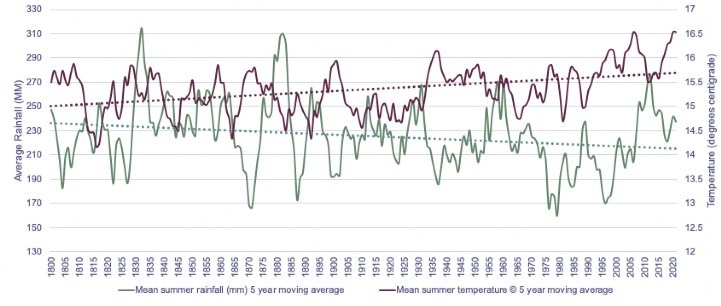Across the UK, wheat is grown extensively as a rainfed crop due to the favourable climate. It covered approximately 1.81 million hectares this year and could well increase if horticultural businesses that aren’t being rewarded adequately by their supply chains return to combinable cropping.
Yields across England in 2022 varied dependent upon soil type – in some locations yields were high, but in areas with lighter soils the drought meant crops failed to reach their potential output.
A study undertaken using the AquaCrop model shows the impact of climate change on winter wheat grown in the East of England would be a reduction in the rainfed yield of between 5.4 per cent and 32.9 per cent.
How can we adapt?
Irrigation might seem to be the most obvious choice. It is currently being used on wheat crops elsewhere in Europe, however its associated costs will challenge profitability and therefore the question arises as to whether it is viable, or whether the inputs needed outweigh the potential yield benefits.
Previous studies provide some evidence: in 2020 a UK grower in Essex irrigated a small, localised area. The impact was an increase in yield across the entire irrigated section, but this was most marked where the soils were of a lighter sandier type, and overall a 2.14t/ha increase in yield was recorded compared with the rest of the field.
A further study on the economics of irrigating wheat found that currently the yield increase and associated cost benefit would only be felt by those farmers who have unused irrigation equipment and unused summer water for direct abstraction.
This suggests that while not viable for much of the UK, irrigation could potentially be a future adaptation measure for yield increase in those areas which are worst impacted, particularly if wheat prices increase.
Balanced against this is the increasing pressures on water as a resource, with another hosepipe ban for much of the country this year. By the 2050s Savills anticipates the UK demand for water is likely to have increased by between 2 per cent and 9 per cent, while the amount of available water is expected to have declined by between 6 per cent and 11 per cent.
The recent High Court decision in Harris v Environment Agency (2022) shows the pressures on water as a resource and could have far reaching implications on abstraction licences. Tim and Geli Harris fought against the abstraction of water from the Catfield Fen for more than a decade. The decision in their favour means that public authorities will need to take appropriate steps to prevent harm to habitats, resulting in potentially tougher water abstraction licence reform. With agriculture holding approximately 64 per cent of abstraction licences, it is clear to see how any change in policy could impact the industry, irrespective of its financial viability.
Alternative options
Currently the most sustainable method of increasing drought resilience is to select deeper rooted crop varieties and improve soil structures.
Looking to the future in the UK, the solution may lie in the Genetic Technology (Precision Breeding) Bill, which will allow gene editing leading to crops that are resistant to pests, disease and more resilient to climate change.
Scientists in Australia have already identified three alternative dwarfing genes that enable wheat seeds to draw moisture stored twice as deep from the soil than current varieties. Meanwhile researchers at the University of Sheffield have engineered wheat to have fewer microscopic stomata, allowing the crop to use water more efficiently while maintaining yields.
Clearly, a number of solutions are required to insulate the agricultural industry from the effects of climate change. Now is the time to start adapting and reviewing the options.
Further information
Contact George Marffy
Savills Rural Research
.jpg)

.jpg)
.jpg)
.jpg)
.jpg)

.jpg)


.jpg)
.jpg)